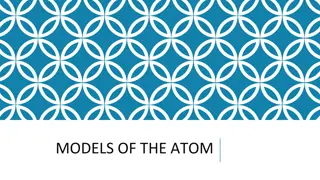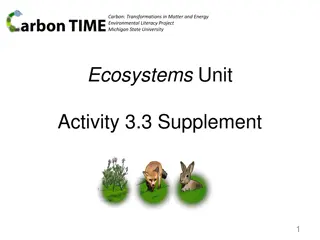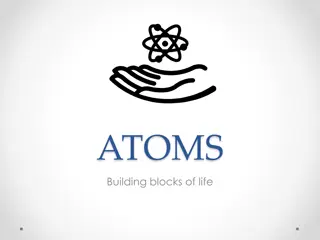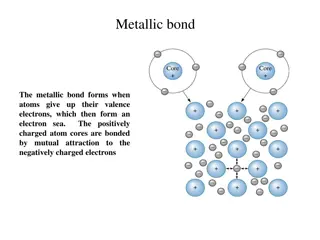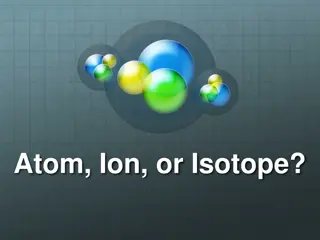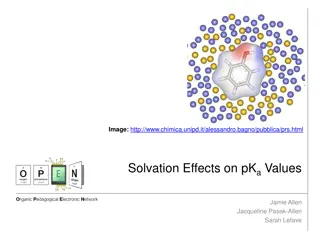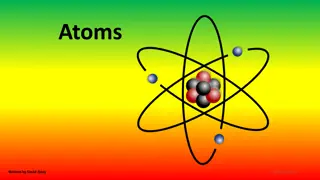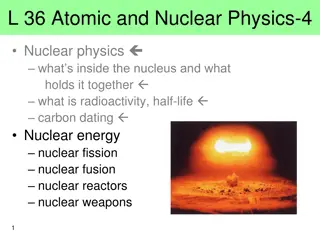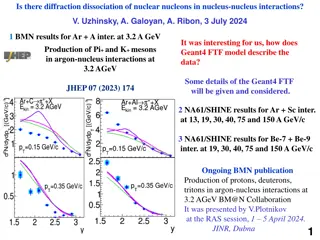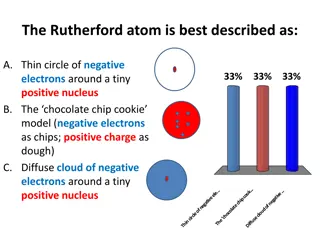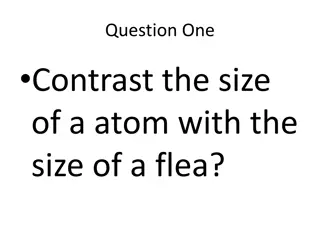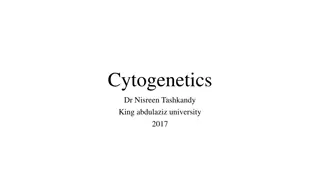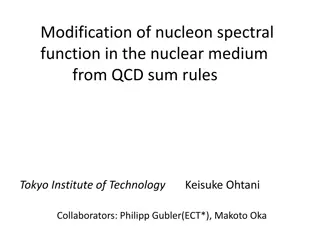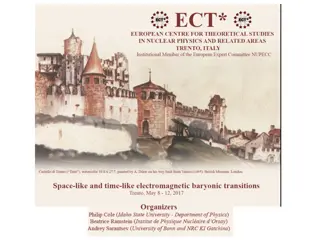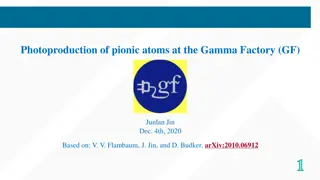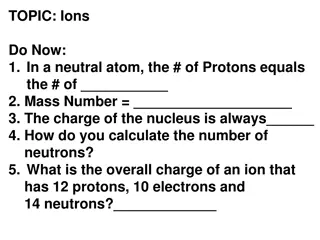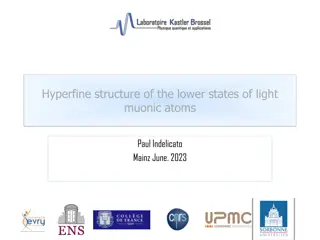Investigating Hadronic Nucleus Polarizability in Muonic Atoms
This work delves into the hadronic nucleus polarizability's impact on the hyperfine structure of light muonic atoms like muonic deuterium and muonic helium-3. It involves calculations related to virtual photoabsorption cross sections, structure functions of lepton-nucleon scattering, and resonance contributions to nucleus polarizability corrections.
Download Presentation

Please find below an Image/Link to download the presentation.
The content on the website is provided AS IS for your information and personal use only. It may not be sold, licensed, or shared on other websites without obtaining consent from the author.If you encounter any issues during the download, it is possible that the publisher has removed the file from their server.
You are allowed to download the files provided on this website for personal or commercial use, subject to the condition that they are used lawfully. All files are the property of their respective owners.
The content on the website is provided AS IS for your information and personal use only. It may not be sold, licensed, or shared on other websites without obtaining consent from the author.
E N D
Presentation Transcript
The correction of hadronic nucleus polarizability to hyperfine structure of light muonic atoms A.V. Eskin (Samara University) In collaboration with A.P. Martynenko QFTHEP - 2017
PURPOSE AND TASKS The purpose of this work is to investigate hadronic nucleus polarizability contribution to the hyperfine structure of the energy spectrum of light muonic atoms (muonic deuterium, muonic tritium, muonic helium-3). Hadronic deuteron polarizability is determined by numerous nuclear reactions of -, - meson production on proton or neutron and the excitation of nucleon resonances. Tasks: The calculation of contribution due to hadronic polarizability of the nucleus to hfs of muonic hydrogen, deuterium, helium, and tritium contains several steps: TT , 1. The calculation of virtual photoabsorption cross sections MAID program in the resonance region; 2. The construction of the structure functions of polarized lepton-nucleon scattering ; 3. The calculation of the resonance and nonresonance contributions to the correction of the nucleus polarizability; on nucleons using the TL ( ( , ), , ) g Q g Q 2 2 1 2 2
TWO PHOTON AMPLITUDES OF LEPTON-NUCLEON SCATTERING Inelastic *+p scattering a) b) Elastic *+p scattering N N N N The amplitude of the elastic scattering is determined by the electromagnetic form factors of the proton (deuteron). We take into account the following resonances N* in MAID: P33(1232), P11(1440), S11(1650), F35(1905), P31(1910), D15(1675), D13(1520), F15(1680), F37(1950) , S11(1535), D33(1700), S31(1620), P13(1720). D. Drechsel, S.S. Kamalov, L. Tiator Unitary isobar model - MAID2007 /Eur. Phys. J., Vol. A34, 2007, Pp.69-97. 3
AMPLITUDE OF COMPTON SCATTERING The polarized structure functions g1( ,Q2) and g2( ,Q2) enter in the antisymmetric part of hadronic tensor W , describing lepton nucleon deep-inelastic scattering: ; + = W W W [ ] [ ] S A ( q q , ) P q P q W Q 2 = + ( + , ) , W g W Q P q P q [ ] 2 S 2 q q q m 1 2 2 2 2 2 ( P , ) ( P , ) g Q g Q 2 2 = + ( ) ( ) , W q S P q S S q P [ ] A 1 2 ( ) q q 2 where is the totally antisymmetric tensor in four dimensions, g1( ,Q2) = m22 G1( ,Q2), g2( ,Q2) = m2 2G2( ,Q2), P is the four-momentum of the nucleon, x = Q2/2m2 is the Bjorken variable, S is the nucleon spin four-vector, normalized to S2= 1, q2= Q2is the square of the four-momentum transfer. The invariant quantity P q is related to the energy transfer in the nucleon rest frame: P q = m2 . The invariant mass of the electroproduced hadronic system W is then W2= m22+ 2m2 Q2= m22+Q2(1/x 1). Here W1and W2are the structure functions for unpolarized scattering. In the DIS regime the invariant mass W must be greater than any resonance in the nucleon. The threshold between the resonance region and the deep-inelastic region is not well defined, but it is usually taken to be at about W2= 4 GeV2. 4
NUCLEUS POLARIZABILITY CONTRIBUTION TO HFS We deal only with the case where the nucleons are assumed to contribute independently to the scattering. This means we neglect bound state effects in nuclei. The polarized structure functions g1( ,Q2) and g2( ,Q2) give the contribution to hfs which is determined by the following expressions: m = + EF is the Fermi energy; HFS N ( ); 1 E E 1 2 F + 2 1 ( 2 ) m 2 2 9 dQ d F2(Q2) is the Pauli form = ( 2 2 3 2 2 ( ) 4 , ) , F Q m G Q 1 2 1 1 factor; 2 2 4 Q Q 0 0 2 2 dQ = ( 2 2 2 12 , , ) m d G Q m2is the nucleon mass. 2 2 2 2 2 Q Q 0 0 Where 0 determines the pion-nucleon threshold: G.M. Zinov ev, B.V. Struminsky, R.N. Faustov, et al., Sov. J. Nucl. Phys., Vol. 11, 1970, P. 715. + 2 2 m Q = + m 0 2 m 2 = 2 ( 2 , ) 1 + 2 ( ) 3 2 ) ( 1 = + , ) 1 + = 2 2 ( ) 1 2 2 ( . Q 2 5
POLARIZED STRUCTURE FUNCTIONS The nucleon polarized structure functions can be measured in the inelastic scattering of polarized electrons on polarized protons. Recent improvements in polarized lepton beams and nucleon targets have made it possible to make accurate measurements of nucleon polarized structure functions g1,2in experiments at SLAC, CERN and DESY. The polarized structure functions can be expressed in terms of virtual photon-absorption cross sections: + Q 2 Q m K 2 ( = ( ( + ( , ) , ) , ) , ) , g Q Q Q Q 2 2 2 2 2 8 1 ( ) 1 / 1 2 / 3 2 TL 2 2 2 2 m K ( = ( + ( + ( , ) , ) , ) , ) , g Q Q Q Q 2 2 2 2 2 2 + 8 1 ( ) Q Q 2 / 1 2 / 3 2 TL 2 2 2 where K = Q2/2m2is the Hand kinematical flux factor for virtual photons, 1/2, 3/2 are the virtual photoabsorption transverse cross sections for the total photon nucleon helicity of 1/2 and 3/2 respectively, TLis the interference term between the transverse and longitudinal photon nucleon amplitudes. In this work we calculate contribution on the basis of the latest experimental data on structure functions g1,2( ,Q2) and theoretical predictions for the cross sections 1/2,3/2,TLobtained in MAID. E HFS N 6
UNITARY ISOBAR MODEL Electromagnetic NN and interaction vertices are defined by following Lagrangians: where electromagnetic vector potential, and -nucleon and pion field operators. When describing the hadron system NN, two options are possible for constructing the Lagrangian interaction: Pseudoscalar Pseudovector Effective Lagrangians for and exchange: and are the operators of meson fields, V is a radiative coupling, determined from the decay V . 7
BREIT-WIGNER PARAMETERIZATION OF THE CROSS SECTIONS GeV GeV For resonance P33(1232) For resonances D13(1520),P11(1440), F15(1680). GeV -the angular momentum of the pion - branching ratio for decay S11(1535) N and N For resonance S11(1535) - Normalization factor pf - three-momentum resonance r in the rest frame of resonance R. mrmass of meson resonance. q and qr - three- momentum pion in the rest system with masses and mr. Jr and rspin and resonance width with mass mr GeV 8
THE PROGRAM OF CALCULATION OF CROSS SECTIONS IN MAID http://portal.kph.uni-mainz.de/MAID 9
THE PROGRAM OF CALCULATION OF CROSS SECTIONS IN MAID http://portal.kph.uni-mainz.de/MAID 10
NONRESONANCE CONTRIBUTION The parametrization of the structure function g1in the nonresonance region is written as follows (SLAC E80, SLAC E130, EMC, SMC): 1 = + + + 2 2 2 ( , ) 1 ( ) ( ) g x Q ax bx cx C f Q F 1 1 1 = 2 ( ) f Q Log pQCD behavior. 2 Q + 2 2 1 Q = = ; ; F F 1 2 2 2 x 2 Q + = + P R [ ]; F F F 2 2 2 2 2 0 Q M R.D. Erbacher A Precision Measurement of the Spin Structure of the Proton at SLAC / SLAC-R-546 ,1999. 11
NONRESONANCE CONTRIBUTION In the nonresonance region, there are a number of parameterizations for the structure function F2 (W, Q2), which were obtained on the basis of experimental data on deeply inelastic lepton-nucleon scattering. F2( ,Q2) is represented as the sum of the Reggeon and Pomeron contributions: Q + 2 = + [ ]; F F F P R Q M 2 2 2 2 2 0 1 x W m 2 2 = = + ( , ) ( ) 1 ( ) ; 1 ; F x Q C t x x ( ) ( ) a t b t 2 R R R R + Q m 2 R R 2 2 R R 1 x W m 2 2 = = + ( , ) ( ) 1 ( ) ; 1 ; F x Q C t x x ( ) ( ) a t b t 2 P P P P + Q m 2 P P 2 2 P P A. Airapetian Inclusive Measurements of Inelastic Electron and Positron Scattering from Unpolarized Hydrogen and Deuterium Targets /JHEP, Vol. 1105, 2011, P. 126. 12
GDH SUM RULE . 1 = p 79 ; 2 2 9 dQ d = ( 2 2 3 N 2 { ( ) 4 ( ) , )} ; F Q m G Q 1 2 1 1 2 2 4 Q Q = . 1 n 91 ; 0 0 2 ( ( ) ) 2 2 2 4 1 S e Ze 3 2 1 2 = = = 2 4 . I S d S GDH 2 M M 0 GDH I GDH I proton,mcb neutron,mcb Contribution to GDH integral Contribution from N states 165,885 133,227 Contribution from N states -8,854 -5,692 Contribution from K meson -1,801 -3,003 Contribution from N state 47,843 50,503 The total contribution 203,072 175,034 The GDH value 204,784 231,783 D. Drechsel, T. Walcher Hadron structure at low Q2 /Rev.Mod.Phys., Vol. 80, 2008, Pp. 731-785. D. Drechsel, B. Pasquini, M. Vanderhaeghen Dispersion relations in real and virtual Compton scattering /Phys. Rev., Vol. 378, 2003, Pp. 99-205. 15
RESULTS For He3the wave-function is almost entirely an S-state with the two protons having opposite spins. Thus all the spin is carried by the neutron neglecting the motion of the nucleons inside the nucleus and their binding: ) , ( 1 g Q x g = = 2 2 He n ( , , ) g x Q g x Q 1 p 2 2 T ( , ) ( , ) x Q 1 1 The contribution of the polarizability of the nucleus to HFS Proton: = Deuteron: 15 = . 8 = 56 = 37 . p d 1 1 . 5 01 + 3 . 2 + d p 2 2 = = 10 36 . = = d d d . 6 26 p p p 1 2 1 2 Helion = Triton = . 8 = 56 . 6 81 p He 1 1 = . 2 71 + 3 . 2 + He p 2 2 = = = = 1 . 4 . 6 26 He He He p p p 1 2 1 2 16
GENERAL RESULTS In the course of the work, complete numerical values for the contributions of the nucleus polarizability to the hyperfine structure of the light muonic atoms were obtained: p 133 . 0 = = . 0 053 meV HFS = meV HFS d . 0 053 meV HFS T = . 0 058 meV HFS 3 He 17
THANK YOU FOR YOUR ATTENTION 10


